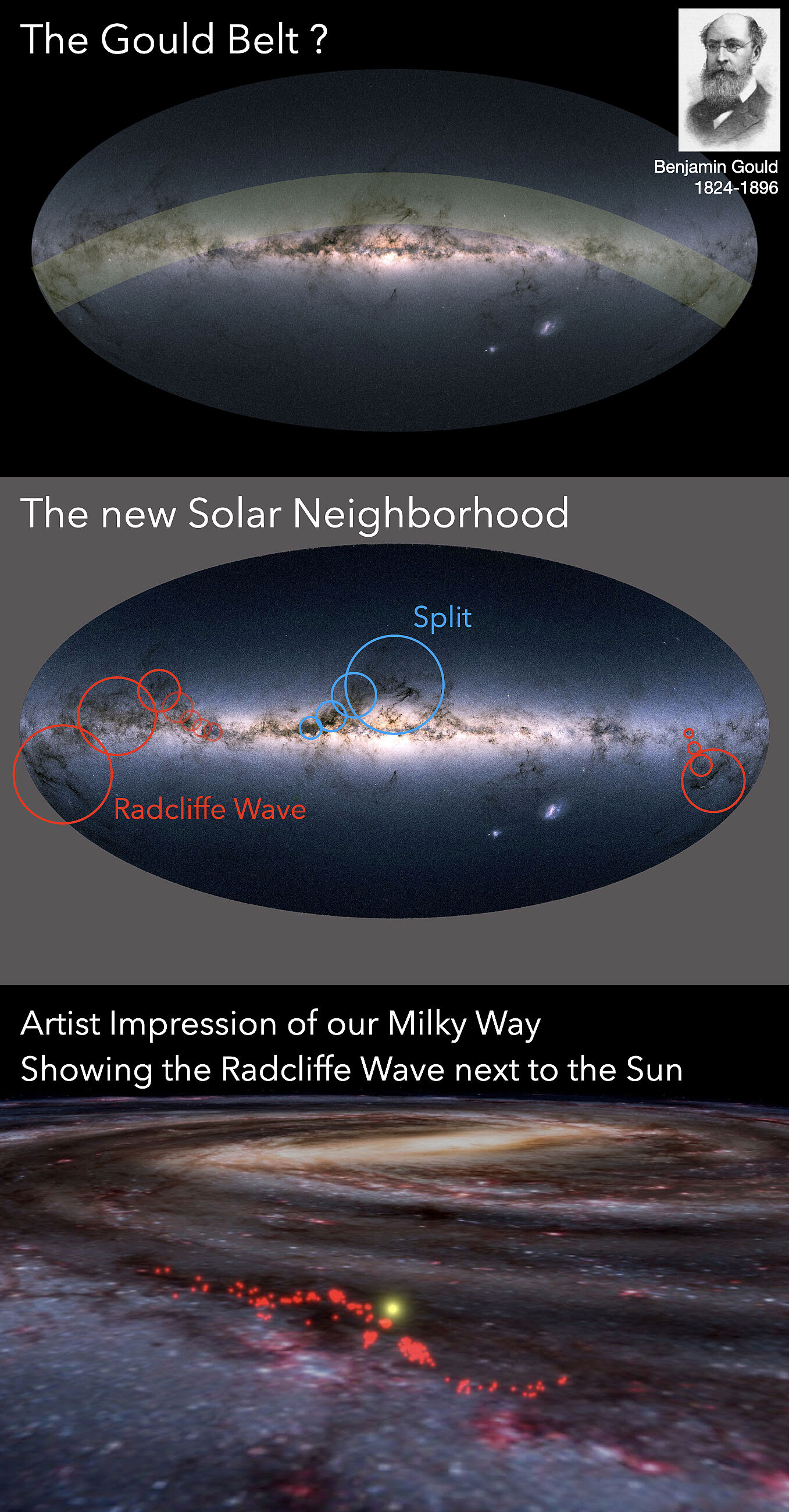Star Formation in the Local Milky Way

Fig. 1. Gould Belt (Gould 1874) versus Radcliffe Wave and Split (Alves et al. 2020, Lallement et al. 2019). Background image: Allsky view of the Milky Way by Gaia DPAC. The bottom image shows an Artists Impression of our Galaxy, the Milky Way, and the undulating pattern of the Radcliffe Wave next to the Sun, by the WorldWide Telescope (worldwidetelescope.org).
Star Formation in the Local Milky Way
Star formation is an ongoing process in the universe. However, this fact is only known since the first half of the 20th century. The Armenian astronomer Viktor Ambartsumian discovered that prominent stellar associations in the sky, so called OB associations, are young disintegrating systems, consisting of the massive and young O and B-type stars. Such stars can only have formed within the last few to several ten million years.
Today it is established that stars are still forming inside giant molecular clouds, the coldest places in our Galaxy. These star-forming clouds can be best studied in the local Milky Way, within about 3000 Light Years from the Sun (or about 1 kiloparsec), where we can map the Sky with the highest possible sensitivity and resolution.
However, our knowledge of local star-forming regions was long restricted to a two-dimensional projected view, since accurate distance estimates to astronomical objects are still one of the most challenging measurements for Astronomers. The Gaia mission, however, has started to change this 2D view (Gaia Collaboration et al. 2016). The precise astrometric data from Gaia allows us to map our Solar Neighbourhood also in the three-dimensional space (3D). The extensive exploitation of Gaia data has started in 2018, with the Gaia Data Release 2 (Gaia DR2, Gaia Collaboration et al. 2018).
The project "Cloud Shape" is taking advantage of the Gaia mission, in combination with auxiliary photometric and radial velocity data (from ESO, ESA, or NASA). The exploitation of these data sets allow us to establish an improved understanding of local star-forming regions by investigating their 3D properties. Only by knowing the full 6D phase space (3D shapes and 3D space motions) enables us to better understand the star formation history in the Local Milky Way.
For instance, it was found recently that the majority of the nearby star-forming regions are arranged within an almost 3 kpc long structure called the Radcliffe Wave, discovered in Alves et al. (2020) published by Nature (see an interactive figure here). On the other side of the Sun another structure was identified called the Split (Lallement et al. 2019). This new view of the local Milky Way challenges previously established concepts, in particular the Gould Belt. This is a structure in the Solar Neighborhood, which was thought to connection all local star-forming regions near the Sun, within about 1300 lightyears (see Figure 1, see also the Radcliffe Wave webpage). However, the newly discovered large-scale structures (Radcliffe Wave and Split) seem to better describe how nearby star-forming regions are arranged and/or connected.
To better understand the newly discovered large-scale features in the local Milky Way, we also need to gain a better understanding of the involved star-forming complexes, including the Orion and Scorpio-Centaurus complexes. These regions are studied in more detail within this FFG project, where we deliver(ed) crucial insights into the formation history of these important regions.
